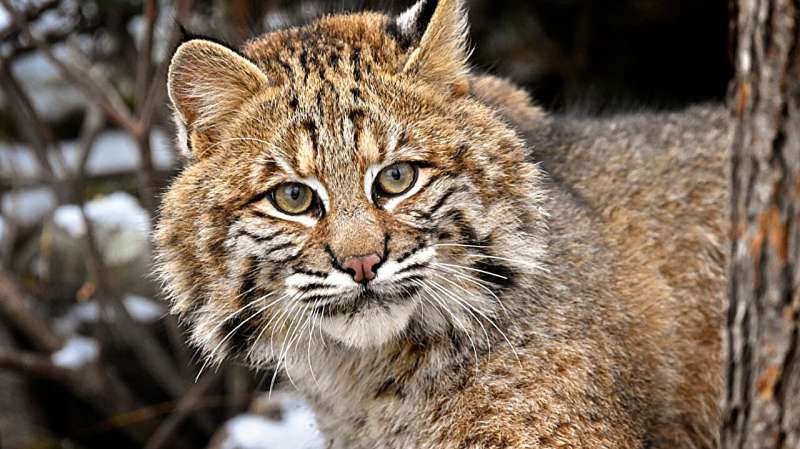
Bobcats, like this one photographed in Otego, New York on Jan. 30, 2024, remain critically low in population, according to Cornell biologists. Credit: Josh Twining / Cornell University
With thousands of strategically placed cameras covering more than 27,000 square miles in central and western New York, biologists have obtained evidence that bobcat populations remain critically low in central and western New York state.
White-tailed deer flourish, red fox and coyote populations remain abundant and stable, and eastern wild turkey and gray fox numbers remain low, according to research based on years of observation by Cornell and the New York State Department of Environmental Conservation (NYSDEC). Their latest report was published February in Biological Conservation.
“Bobcats probably displayed one of the more concerning trends that we saw,” said lead author Joshua Twining, a postdoctoral researcher in the New York Cooperative Fish and Wildlife Research Unit, which is a U.S. Geological Survey unit at Cornell led by Angela Fuller.
In statistical scrutiny, occupancy probabilities—important for managing wildlife species and conservation—can range from zero to one. Numbers closer to one mean that a species likely occurs in an area; zero is certainty of its absence.
From 2014 to 2021, the estimated mean predicted probability of occupancy for historically extirpated bobcats in central and western New York ranged from a low of 0.02 in 2015 to a high of 0.12 in 2019, and then back down to 0.05 in 2021, according to motion-tripped photographic data.
Due to the very low occupancy observed, “it would be impossible for us to detect a decline in bobcat occupancy in this region without the species being extirpated,” Twining said.
Easily more than twice the size of a large house cat, bobcats are prized for their soft pelts, according to the NYSDEC. The bobcats all have large paws; the males can be 3 feet long and weigh more than 30 pounds. Females are a few inches shorter.
“Bobcats are an important predator in northeastern ecosystems, eating rodents, squirrels, snowshoe hare, rabbits and deer,” Fuller said. “In addition, bobcats are valued by hunters and trappers, photographers and wildlife enthusiasts. There is also an existence value, or ‘non-use’ value, for bobcats. People like to know that they live on the landscape.”
Twining said New York has variable hunting and trapping seasons for bobcats, depending on the region. Some areas surveyed were not open to bobcat hunting or trapping; areas along the New York-Pennsylvania border have been open to bobcat harvest since 2013.
While gray fox numbers were low, the population was stable, the paper said. In all years, the eastern wild turkey’s occupancy was low, ranging from 0.07 to 0.25.
The motion-activated, camera-trap research originally sought to estimate occupancy trends and abundance of fishers, which are carnivorous weasels. The first survey was conducted in 2014 at 608 sites and repeated in 2015 at 599 sites. Subsequently, the biologists conducted surveys in 2019 (584 sites), 2020 (603) and 2021 (601) in the same areas.
“Through the establishment of a robust quantitative monitoring program,” said Fuller, who is a faculty fellow at the Cornell Atkinson Center for Sustainability, “we provide critical empirical data on the population trends and the drivers of occupancy and abundance on a landscape scale for a variety of species in New York—a method that can be used to inform species management and conservation into the future.”
In addition to Fuller and Twining, the co-authors of “Landscape-Scale Population Trends in the Occurrence and Abundance of Wildlife Populations Using Long Term Camera-Trapping Data” were David Kramer of NYSDEC and Kelly Perkins, research associate with the NYCFWRU and a doctoral student in the Department of Natural Resources and the Environment (CALS).
More information:
Joshua P. Twining et al, Landscape-scale population trends in the occurrence and abundance of wildlife populations using long term camera-trapping data, Biological Conservation (2024). DOI: 10.1016/j.biocon.2023.110398
Citation:
Trail cameras track ‘critically low’ New York bobcat population (2024, February 13)
retrieved 13 February 2024
from https://phys.org/news/2024-02-trail-cameras-track-critically-york.html
This document is subject to copyright. Apart from any fair dealing for the purpose of private study or research, no
part may be reproduced without the written permission. The content is provided for information purposes only.
>>> Read full article>>>
Copyright for syndicated content belongs to the linked Source : Phys.org – https://phys.org/news/2024-02-trail-cameras-track-critically-york.html
